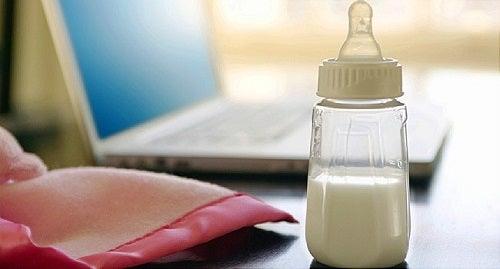Should you go with glass, plastic, or disposable bottles? Do you need a bottle warmer and sterilizer?
Fortunately, you don’t need all the products out there, but a few will come in handy.
Baby Bottle Basics: Plastic Vs. Glass
You've got three basic choices:
- Plastic
Pros: They’re lightweight, strong, and unbreakable.
Cons: Plastic baby bottles may not last as long as glass. And if you’re using older, second-hand bottles, they may have bisphenol A (BPA), a chemical used to make hardened plastic. The FDA banned the use of BPA in 2012 from baby bottles and sippy cups, but older ones may have it.
- Glass
Pros: They last a long time, and you can boil them for a deep clean.
Cons: They’re heavier than plastic and may shatter if you drop them.
- Disposable
Pros: These reusable plastic bottles have a disposable sterilized liner for each feeding. They’re very convenient because clean-up is quick.
Cons: The disposable inserts may not be great for the environment, and the bottles are usually more expensive than regular plastic or glass. You also need to have a supply of liners, which can be costly.
Which kind should you choose? Ask for advice from friends, family, or your baby’s paediatrician. Experiment. Try a few and see which you and your baby like best.
Once you pick a specific bottle, buy at least a dozen of them. Even if you’ll be breastfeeding, you may want some extra baby bottles for pumped breast milk storage.
Nipples for Bottles
Baby bottle nipples are usually rubber or silicone. They can be rounded, wide, flat, or shaped to mimic a mother’s nipple in the baby’s mouth. Depending on the size of the nipple hole, they also have different flow rates, from slow to fast.
As with bottles, your baby may prefer a certain nipple type. The only way to find out is to try them out. To get started, ask friends, family, and your baby’s doctor about which types and brands they recommend.
Get at least 12 nipples and covers. Remember, these nipples crack and leak with use, so you may need to buy more over time. And the sizes change as baby grows.
Baby Bottle Gear
There are lots of accessories to choose from, including brushes, carrying cases, sterilizers, and dishwasher bottle baskets.
Paediatricians and parents generally agree that the following items are helpful:
- 1 baby bottle brush
- 1 nipple brush
- 6-12 bibs
- 1 breast pump with storage bottles (if you’re breastfeeding)
- 12 burp cloths, receiving blankets, or clean cloth diapers
Are Plastic Baby Bottles Safe?
If you’re buying brand new bottles, you can rest assured that they’re safe. Since the FDA banned BPA from baby bottles and sippy cups, those for sale today shouldn’t have this chemical.
6 Dos & Don’ts
- Don’t sterilize glass baby bottles and nipples before every use. That practice was only necessary in the past, when local water supplies were not as reliably clean as they are now.
You may want to sterilize new glass baby bottles and new nipples by putting them in boiling water for 5 minutes After that, you can wash bottles in the dishwasher, which cleans better than hand-washing them, or wash by hand with hot, soapy water and rinse well.
- Do replace baby bottles and nipples if you find a certain set just doesn’t agree with your baby’s needs.
- Do replace a glass baby bottle if it’s cracked or chipped.
- Do replace a plastic baby bottle if it’s cracked, leaks, is discoloured, or smells bad.
- Do replace a nipple if it’s discoloured or isn't in good shape (a damaged nipple can be a choking hazard), or if milk comes out too fast.
To test the flow, turn the bottle upside down. Only a few drops should come out. If more do, the hole is too big, and your baby may get more formula than he can handle. Nipple packages should state the flow rate on them.
- Do label breast milk bottles for storage.
- Don’t buy a baby bottle warmer unless you really want one. Standing a baby bottle in a glass of hot water for a few minutes is easier and less expensive. Also, don't heat your baby’s bottle in the microwave. That can create hot spots in the liquid because microwaves don't heat evenly.
- Don't feed baby the rest of a bottle started earlier, even if it was refrigerated.
SOURCE: https://www.webmd.com/












